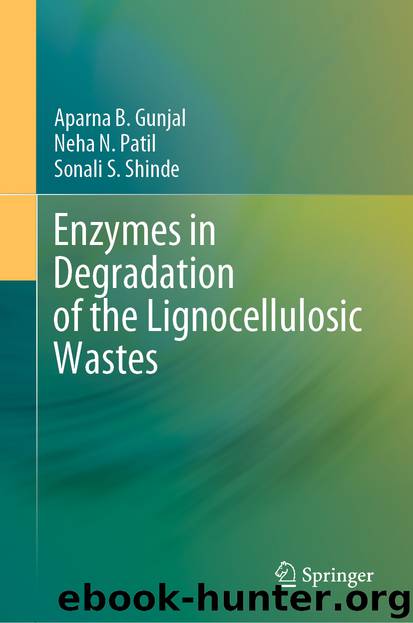Enzymes in Degradation of the Lignocellulosic Wastes by Aparna B. Gunjal & Neha N. Patil & Sonali S. Shinde

Author:Aparna B. Gunjal & Neha N. Patil & Sonali S. Shinde
Language: eng
Format: epub
ISBN: 9783030446710
Publisher: Springer International Publishing
4.2 Lignin Occurrence, Biogenesis, and Biodegradation
Lignins are plant polymers derived from the hydroxycinnamyl alcohols or monolignols p-coumaryl, coniferyl, and sinapyl. It was a debatable question on what are lignins? Histochemical studies investigated on lignin as a plant polymer. Total lignin contents are determined by solvent extraction, alkali extraction, and more recent spectroscopic methods including NMR, infrared, and UV methods. Water-soluble and water-insoluble intermediate lignins degradation can be detected under solid-state and submerged fermentation. The intermediate can be extracted with polar solvent. Degradation of lignins to generate biofuels strongly depends on lignin’s chemical structure and fractionation process. These materials are decomposed in nature by several microorganisms like fungi and bacteria. Lignocellulosic biomass decomposition is carried out primarily by microbial involvement, utilizing it as carbon and nutrient/energy source for their growth. Lignocellulosic hydrolysis yield simple sugars that can be utilized for biofuel production. Microbes are known to break down the lignin and cellulose to utilize it as energy source. Few fungi and certain bacteria can also decolorize the cellulose.
Lignin is a complex molecule with a non-repeating phenylpropane backbone biosynthesized by random polymerization of phenylpropanoid precursor with irregular structure. The two-dimensional structure of lignin is represented in Fig. 4.1. The major building blocks are monolignols or hydroxycinnamyl alcohols (Vanholme et al. 2010). Polymerization can be carried out in vitro to produce synthetic lignin or dehydrogenate polymerizes (DHP). The non-repeating structure is an important feature for biological delignification. Diversity of lignins is observed in the interunits making it difficult to beak the interunit bonds, complicating its use as a carbon and energy source for biological degradation. Degradation of lignins is only possible with few organisms that harbor the pathway to degrade it. The derivatives of lignin are shown is Fig. 4.2.
Fig. 4.1Two-dimensional structure of lignin polymer molecule
Download
This site does not store any files on its server. We only index and link to content provided by other sites. Please contact the content providers to delete copyright contents if any and email us, we'll remove relevant links or contents immediately.
| Automotive | Engineering |
| Transportation |
Whiskies Galore by Ian Buxton(41879)
Introduction to Aircraft Design (Cambridge Aerospace Series) by John P. Fielding(33064)
Small Unmanned Fixed-wing Aircraft Design by Andrew J. Keane Andras Sobester James P. Scanlan & András Sóbester & James P. Scanlan(32743)
Craft Beer for the Homebrewer by Michael Agnew(18140)
Turbulence by E. J. Noyes(7936)
The Complete Stick Figure Physics Tutorials by Allen Sarah(7307)
Kaplan MCAT General Chemistry Review by Kaplan(6867)
The Thirst by Nesbo Jo(6826)
Bad Blood by John Carreyrou(6552)
Modelling of Convective Heat and Mass Transfer in Rotating Flows by Igor V. Shevchuk(6391)
Learning SQL by Alan Beaulieu(6210)
Weapons of Math Destruction by Cathy O'Neil(6143)
Man-made Catastrophes and Risk Information Concealment by Dmitry Chernov & Didier Sornette(5921)
Digital Minimalism by Cal Newport;(5664)
Life 3.0: Being Human in the Age of Artificial Intelligence by Tegmark Max(5474)
iGen by Jean M. Twenge(5366)
Secrets of Antigravity Propulsion: Tesla, UFOs, and Classified Aerospace Technology by Ph.D. Paul A. Laviolette(5309)
Design of Trajectory Optimization Approach for Space Maneuver Vehicle Skip Entry Problems by Runqi Chai & Al Savvaris & Antonios Tsourdos & Senchun Chai(5011)
Pale Blue Dot by Carl Sagan(4912)
